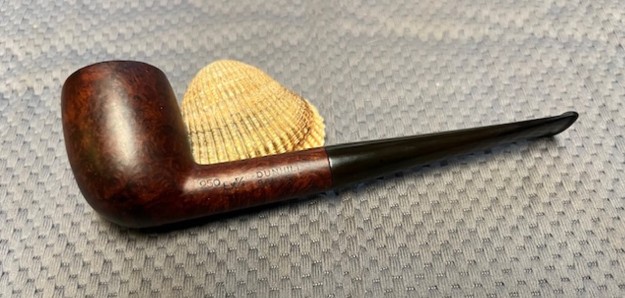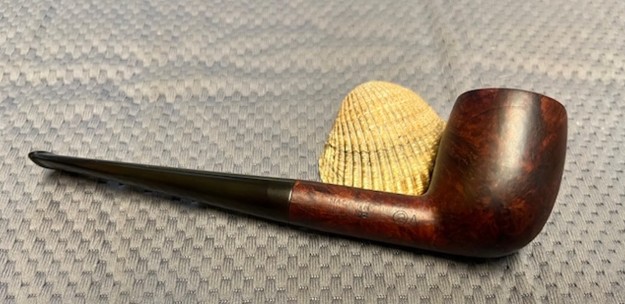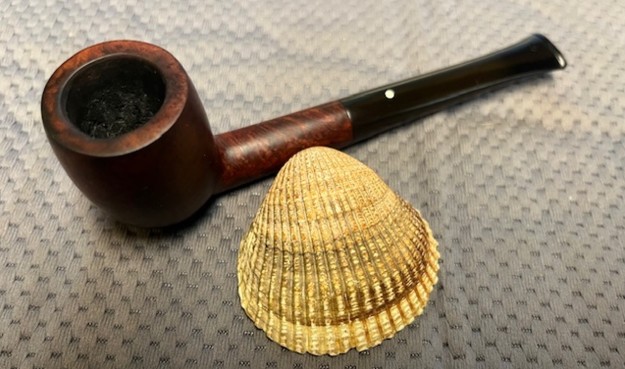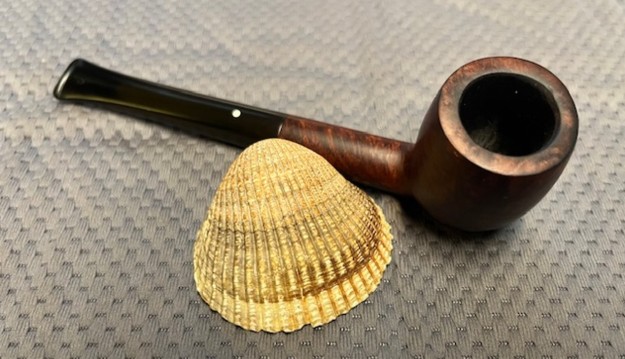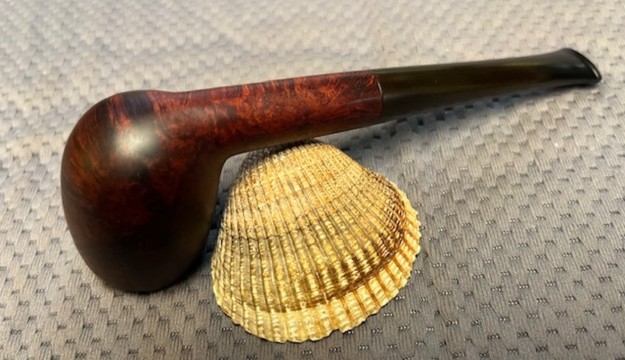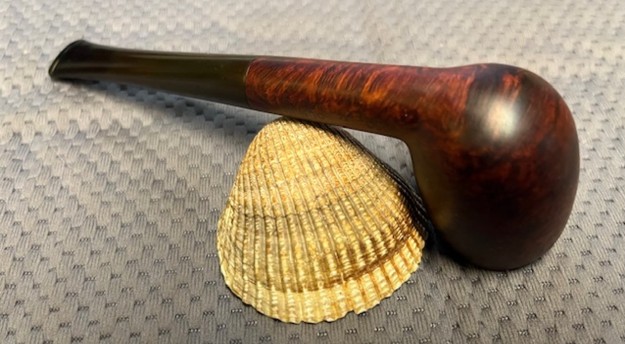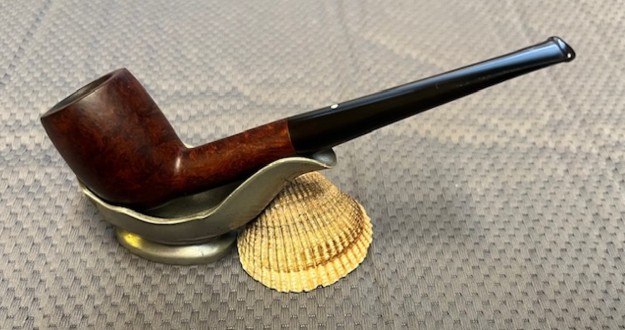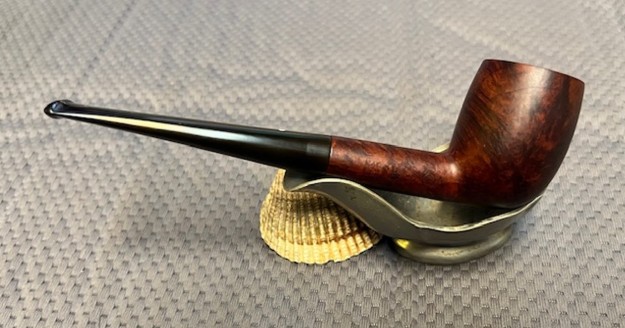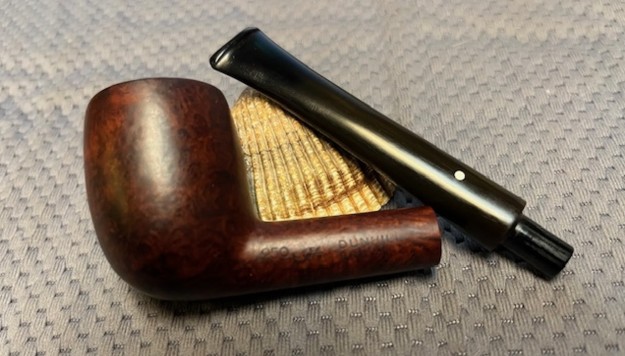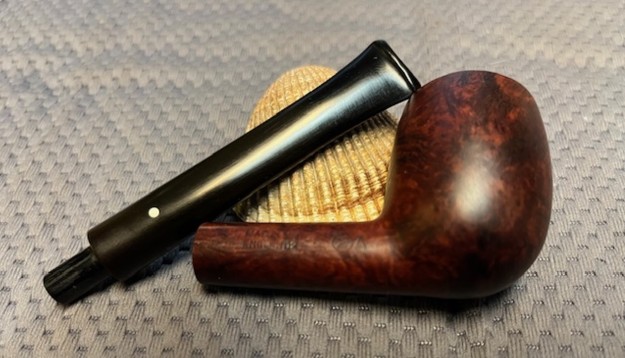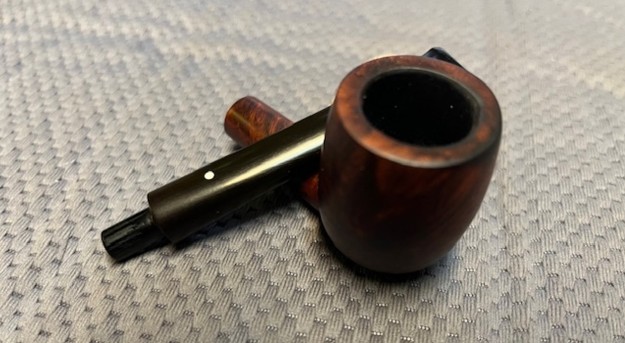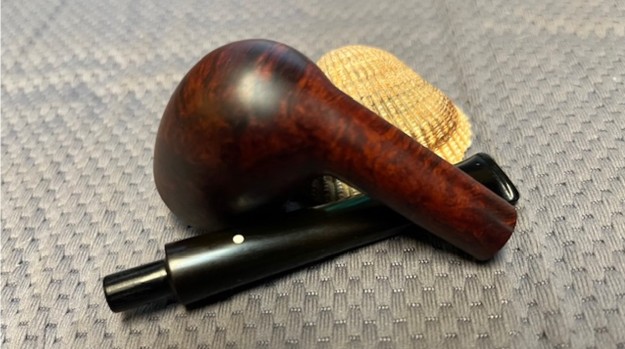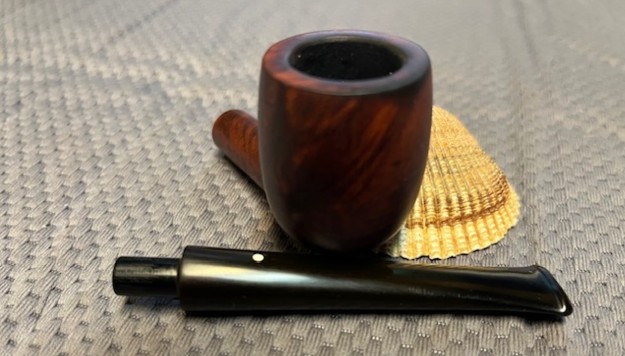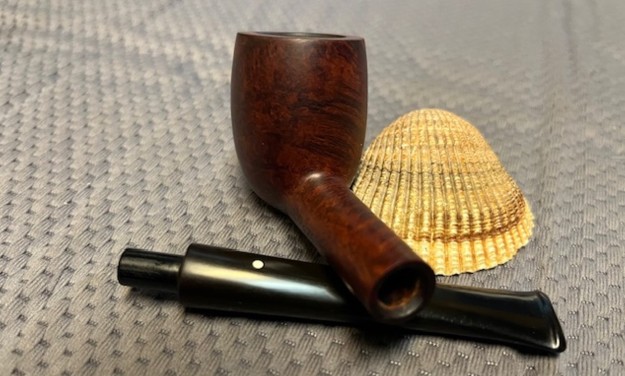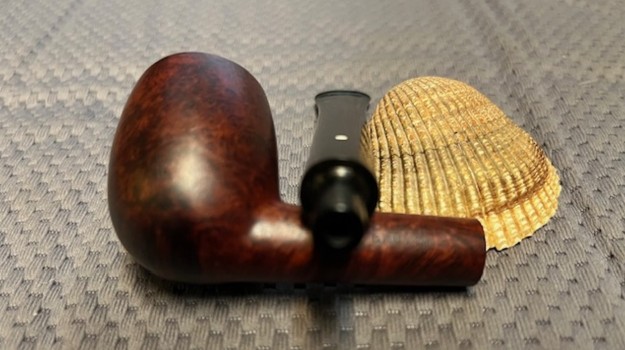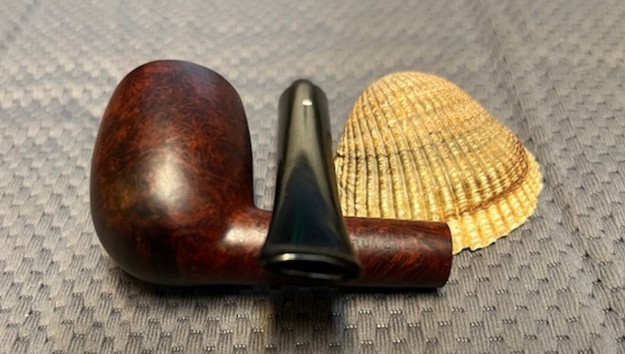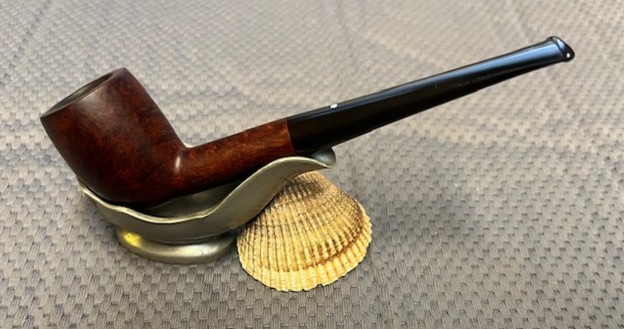Blog by Steve Laug
The next pipe that I am working on came from our connection in Copenhagen, Denmark we purchased on 01/08/24. It was very dirty and rich combination of red and brown stains when it started. The smooth finish around the bowl was dirty and had hand oils ground into the finish. The bowl had a thick cake and a coat of lava flowing onto the inner edge and the rim top. There was also some burn damage on the rim top and the outer edge of the bowl and down the front. The classic fishtail stem was very dirty, oxidized and had light tooth marks and chatter on both sides ahead of the button. There was a white spot on the topside of the stem. The fit of the stem to the shank is perfect. The pipe is stamped on the left side of the shank and read 250 EX F/T followed by Dunhill [over] Bruyere. On the right side it is stamped Made in London [over] England with the superscript 2 (date stamp) after the D of England. That is followed by 2 (size of pipe) in a circle A for Bruyere. Jeff took photos of the pipe so I could have a sense of what it looked like before he started his work on it.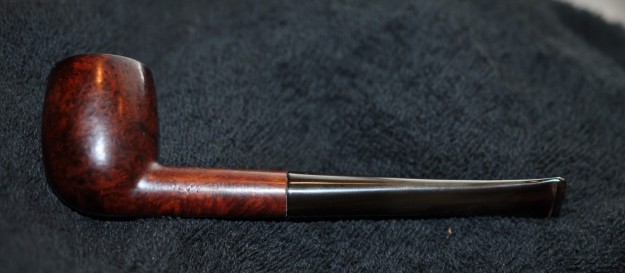
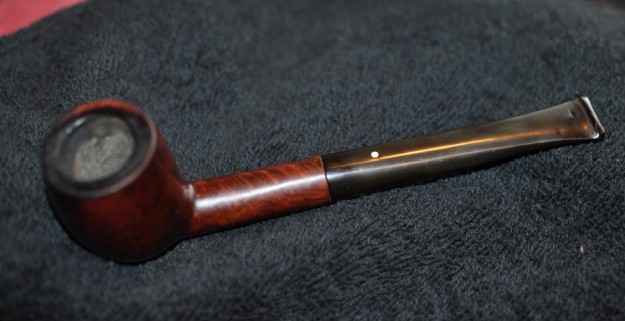 Jeff took photos of the bowl and rim top to show the cake in the bowl with remnants of tobacco stuck on the walls of the bowl. There was a thick lava build up on the top of the rim and the edge of the bowl. There appeared to be some burn damage on the top front and outer edge of the bowl. Only clean up would tell the full story. Jeff took photos of the top and underside of the stem showing the tooth chatter, marks and oxidation on the stem.
Jeff took photos of the bowl and rim top to show the cake in the bowl with remnants of tobacco stuck on the walls of the bowl. There was a thick lava build up on the top of the rim and the edge of the bowl. There appeared to be some burn damage on the top front and outer edge of the bowl. Only clean up would tell the full story. Jeff took photos of the top and underside of the stem showing the tooth chatter, marks and oxidation on the stem.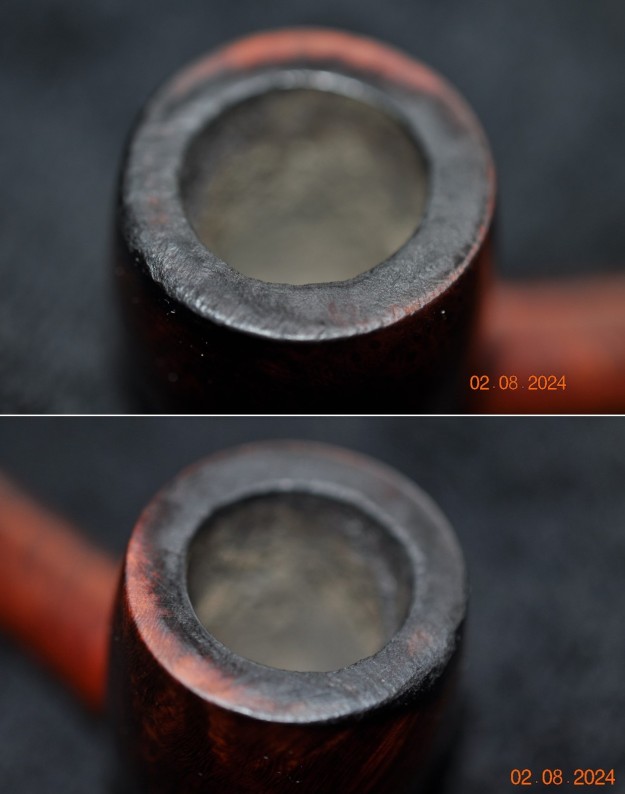
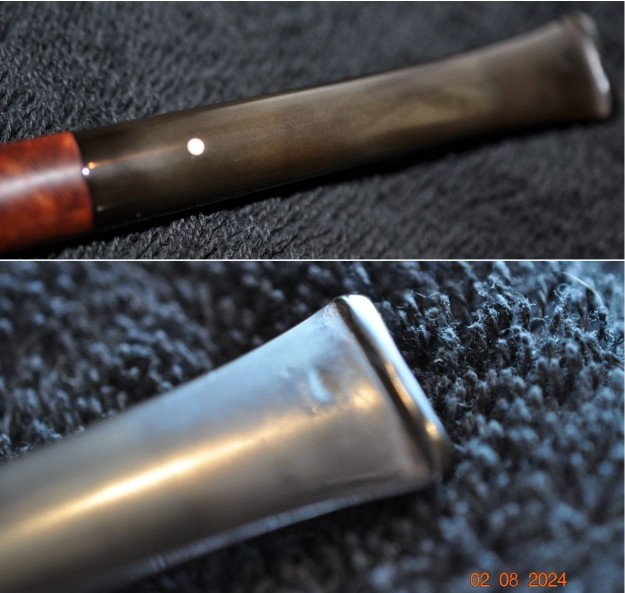
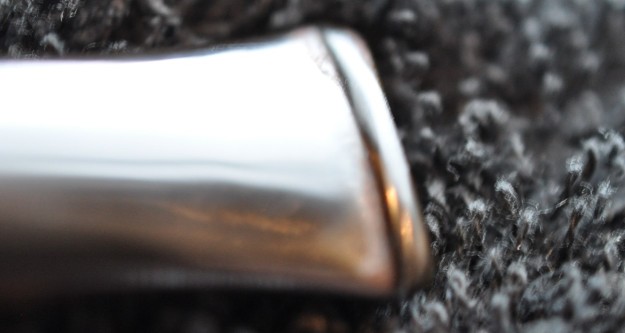 Jeff took photos of the sides and heel of the bowl to show the condition of the finish. You can see the grime in the finish around the sides of the bowl and shank. Even under the dirt and debris of the years it looked very good.
Jeff took photos of the sides and heel of the bowl to show the condition of the finish. You can see the grime in the finish around the sides of the bowl and shank. Even under the dirt and debris of the years it looked very good.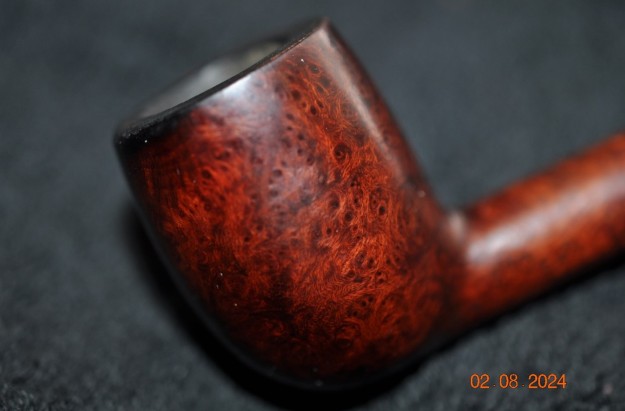
 Jeff took photos of the stamping on the sides of the shank. The stamping was faint in spots but nonetheless still readable as you can see from the photos. It read as noted above.
Jeff took photos of the stamping on the sides of the shank. The stamping was faint in spots but nonetheless still readable as you can see from the photos. It read as noted above. 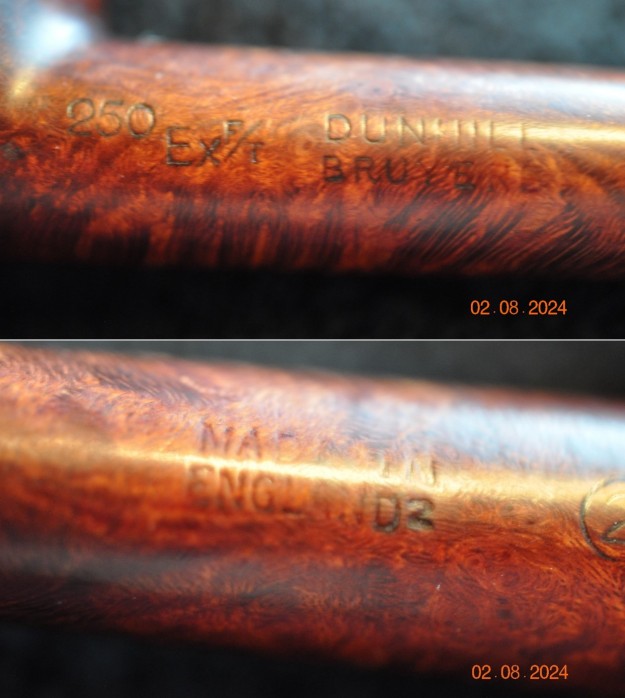
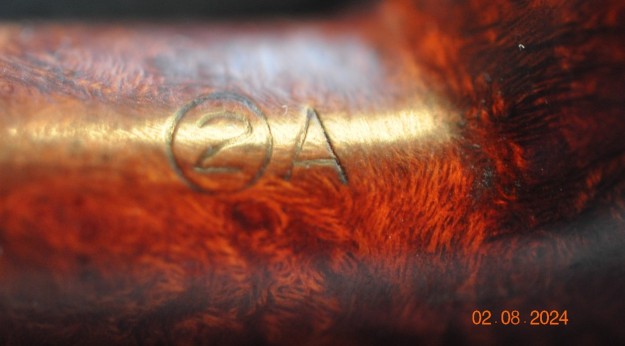 I turned to Pipedia’s section on Dunhill Root Briar Pipes to get a bit of background on the Dunhill finishes (https://pipedia.org/wiki/Dunhill#Root_Briar). I quote:
I turned to Pipedia’s section on Dunhill Root Briar Pipes to get a bit of background on the Dunhill finishes (https://pipedia.org/wiki/Dunhill#Root_Briar). I quote:
Bruyere
The original finish produced (usually made using Calabrian briar), and a big part of developing and marketing the brand. It was the only finish from 1910 until 1917. A dark reddish-brown stain. Before the 1950s, there were three possible finishes for Dunhill pipes. The Bruyere was a smooth finish with a deep red stain, obtained through two coats, a brown understain followed by a deep red.
There was a link on the above site to a section specifically written regarding the Bruyere finish (https://pipedia.org/wiki/Dunhill_Bruyere). I turned there and have included the information from that short article below.
Initially, made from over century-old briar burls, classified by a “B” (denoted highest quality pipe); “DR” (denoted straight-grained) and an “A” (denoted first quality), until early 1915. After that, they became a high-end subset to the Dunhill ‘Bruyere’. The DR and B pipes, a limited production, they should be distinguished as hand-cut in London from burls as opposed to the Bruyere line which was generally finished from French turned bowls until 1917, when the Calabrian briar started to be used, but not completely. Only in 1920 Dunhill took the final step in its pipe making operation and began sourcing and cutting all of its own bowls, proudly announcing thereafter that “no French briar was employed”.
Bruyere pipes were usually made using Calabrian briar, a very dense and hardy briar that has a modest grain but does very well with the deep red stain.
“Before the 1950s, there were three possible finishes for Dunhill pipes. The Bruyere was a smooth finish with a deep red stain, obtained through two coats, a brown understain followed by a deep red. The Shell finish was the original sandblast with a near-black stain (though the degree to which it is truly black has varied over the years). Lastly, the Root finish was smooth also but with a light brown finish. Early Dunhill used different briars with different stains, resulting in more distinct and identifiable creations… Over the years, to these traditional styles were added four new finishes: Cumberland, Dress, Chestnut and Amber Root, plus some now-defunct finishes, such as County, Russet and Red Bark.”
There was also a link to a catalogue page that gave examples and dates that the various finishes were introduced (https://pipedia.org/wiki/File:Dunnypipescatalog-1.png).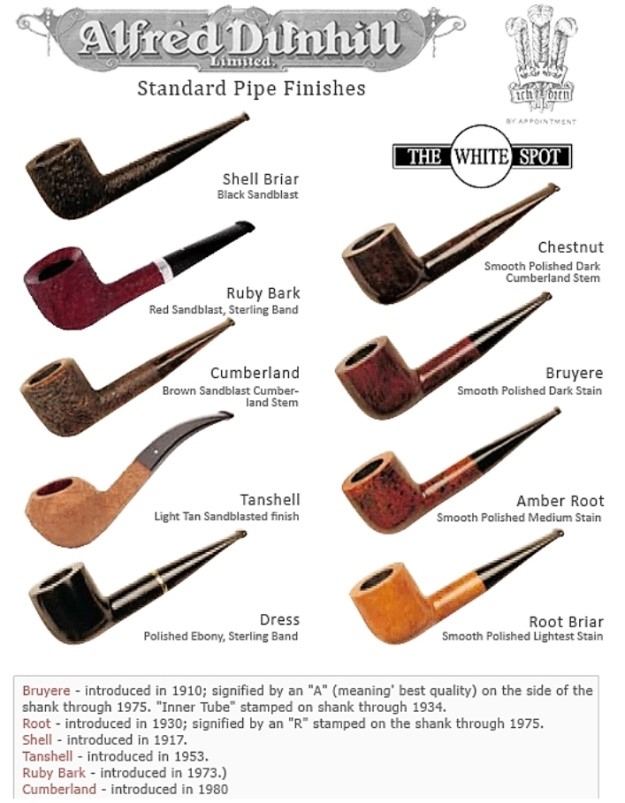 I turned to Pipephil’s dating guide to show how I arrived at the date of manufacture for this pipe (http://www.pipephil.eu/logos/en/dunhill/cledat-en1a.html). I am including the chart that is provided there for the dating a pipe. I have drawn a red box around the section. Since the pipe I am working on has a suffix 2 that is raised. It to the 1960 line on the chart below. It also gave me the formula for dating the pipe – 1960 + suffix 2 = 1962.
I turned to Pipephil’s dating guide to show how I arrived at the date of manufacture for this pipe (http://www.pipephil.eu/logos/en/dunhill/cledat-en1a.html). I am including the chart that is provided there for the dating a pipe. I have drawn a red box around the section. Since the pipe I am working on has a suffix 2 that is raised. It to the 1960 line on the chart below. It also gave me the formula for dating the pipe – 1960 + suffix 2 = 1962.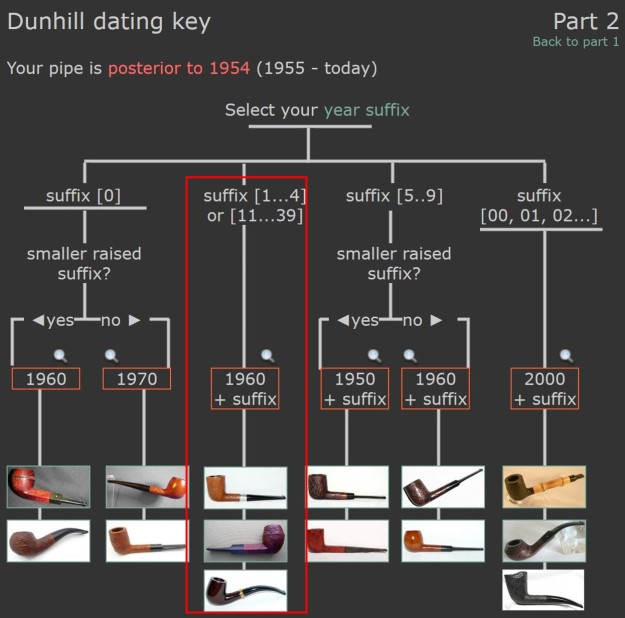 In an earlier blog I had come across the EX stamp – in this case 250EX. From what I found on that blog I quote below: https://rebornpipes.com/2020/05/09/breathing-life-into-a-1957-or-is-it-a-1967-dunhill-root-briar-251-ex606-billiard/
In an earlier blog I had come across the EX stamp – in this case 250EX. From what I found on that blog I quote below: https://rebornpipes.com/2020/05/09/breathing-life-into-a-1957-or-is-it-a-1967-dunhill-root-briar-251-ex606-billiard/
I posted a question on the stamping on the Tobacco Pipe Restorers Group on Facebook and got this response from Alfredo Baquerizo:
This is a Root Briar from 1957 shape 251, group 3 and the R is for root. It’s an EX an exchange pipe by warranty Dunhill system. The 606 I think that is the exchange pipe number, I’m not sure.
I also posted on the Vintage Dunhill Pipes Group on Facebook and enjoyed the responses. One of the posters there, Jean-Paul Varon gave this information.
Ex606 = exchange of a pipe under guarantee.
That was the extent of the information that I could find at this point. It seems likely that the EX is the Dunhill Exchange Warranty system. Is it possible that the 250EX could be that the original 250 F/T pipe has been exchanged for this replacement?
I now knew that I was working on a Bruyere that came out in 1962. The shape of the pipe was one of many Billiards that Dunhill put out and that the #250EX F/T was a normal billiard shape with a taper stem. As noted above the EX could be an exchange.
I turned to work on the pipe itself. Jeff had carried out his usual thorough cleanup of the pipe. He had reamed it with a PipNet reamer to remove the cake and cleaned the reaming up with a Savinelli Fitsall Pipe Knife. He scrubbed the internals of the bowl and stem with alcohol, cotton swabs and pipe cleaners. He scrubbed the externals with undiluted Murphy’s Oil Soap and rinsed the bowl off with running water. He soaked the stem in Briarville’s Pipe Stem Deoxidizer and once it had soaked rinsed it off with warm water to remove the residual solution. He dried it off and scrubbed it down with Soft Scrub All-Purpose cleaner to remove any oxidation that was still on the stem. The pipe looked very clean when I received it.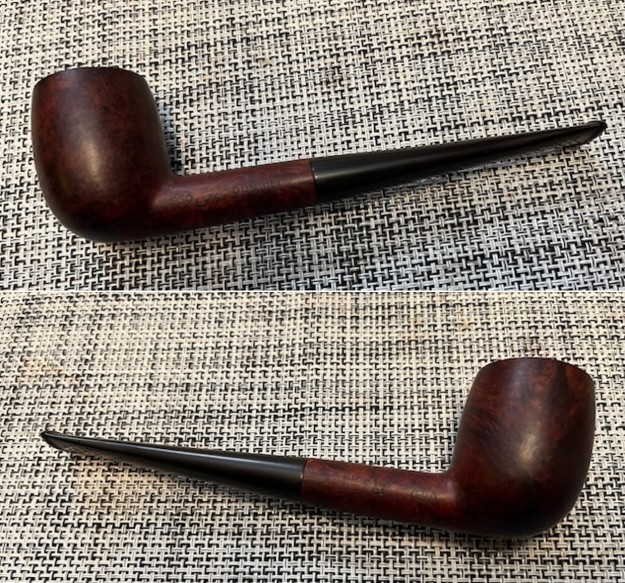
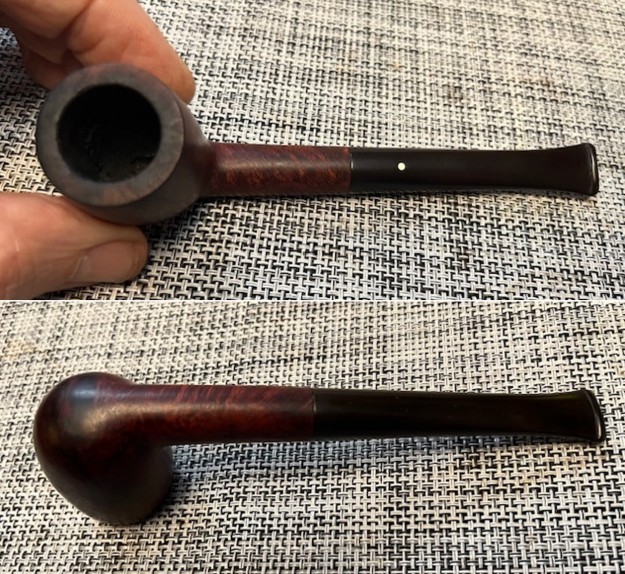 I took a photo of the rim top to show the condition. You can see the clean bowl. The bowl is in excellent condition and is clean. The rim top and the inner edge show some darkening and damage to the inner and outer edge. The stem came out looking clean. There were some tooth marks and chatter on both sides ahead of the button.
I took a photo of the rim top to show the condition. You can see the clean bowl. The bowl is in excellent condition and is clean. The rim top and the inner edge show some darkening and damage to the inner and outer edge. The stem came out looking clean. There were some tooth marks and chatter on both sides ahead of the button. 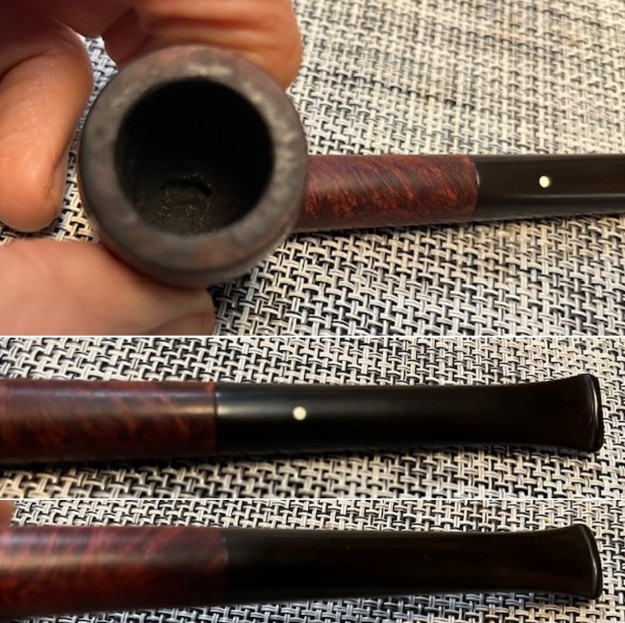 I took photos of the stamping on the shank. It is faint but still very readable. There was also a very faint stamp on the stem but I am still not certain it is the correct stem because of the fit and shape of the stem. I removed the stem from the shank and took a photo of the pipe parts to show what I was working with.
I took photos of the stamping on the shank. It is faint but still very readable. There was also a very faint stamp on the stem but I am still not certain it is the correct stem because of the fit and shape of the stem. I removed the stem from the shank and took a photo of the pipe parts to show what I was working with.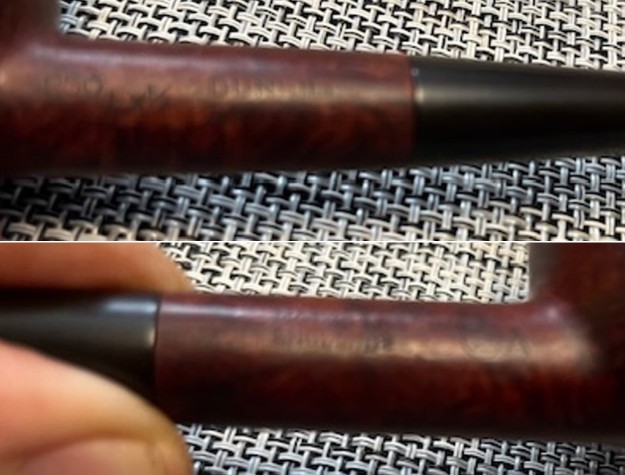
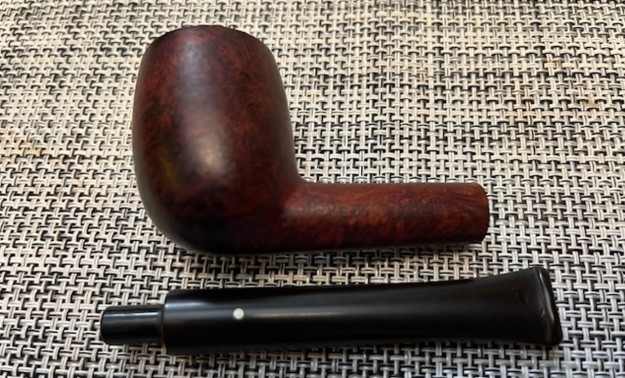 This weekend when I visited with Jeff I picked up a bottle of Before & After Briar Cleaner developed by Mark Hoover that had been sent to me. This evening I decided to try out the product. I applied it to the bowl and scrubbed the surface with a tooth brush. I wiped off the product with a clean paper towel and it had removed a lot of the remaining darkening on the surface of the briar. I took photos of the pipe to show how well it worked. I was very pleased how clean the rim top and side of the bowl came out.
This weekend when I visited with Jeff I picked up a bottle of Before & After Briar Cleaner developed by Mark Hoover that had been sent to me. This evening I decided to try out the product. I applied it to the bowl and scrubbed the surface with a tooth brush. I wiped off the product with a clean paper towel and it had removed a lot of the remaining darkening on the surface of the briar. I took photos of the pipe to show how well it worked. I was very pleased how clean the rim top and side of the bowl came out.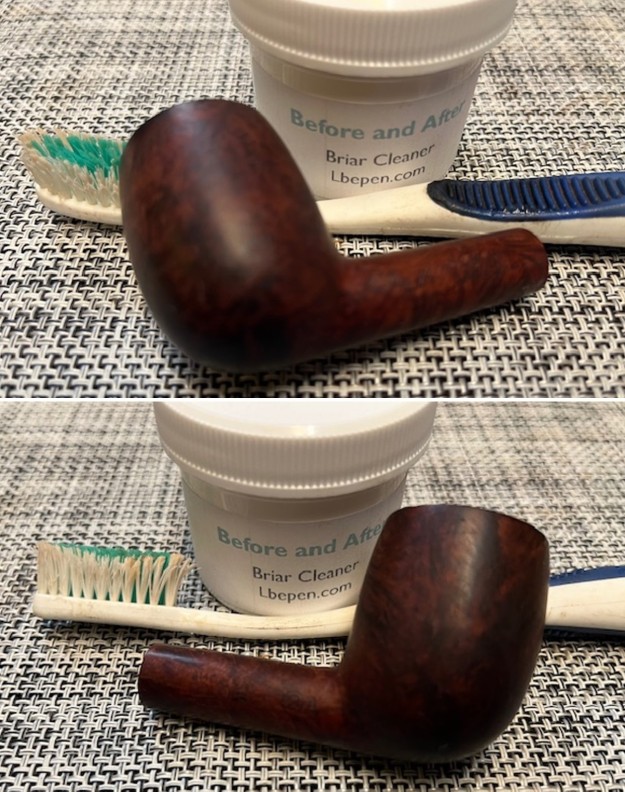
 I started my work on the pipe by addressing the damage on the inner edge of the bowl to bring it back to round using a folded piece of 220 grit sandpaper. I gave it a slight bevel to accommodate the damage. Even after reworking the edge there was some damage that remained on the left front inner and outer edge of the bowl. I left it as removing it would damage the shape and thickness of the bowl walls.
I started my work on the pipe by addressing the damage on the inner edge of the bowl to bring it back to round using a folded piece of 220 grit sandpaper. I gave it a slight bevel to accommodate the damage. Even after reworking the edge there was some damage that remained on the left front inner and outer edge of the bowl. I left it as removing it would damage the shape and thickness of the bowl walls.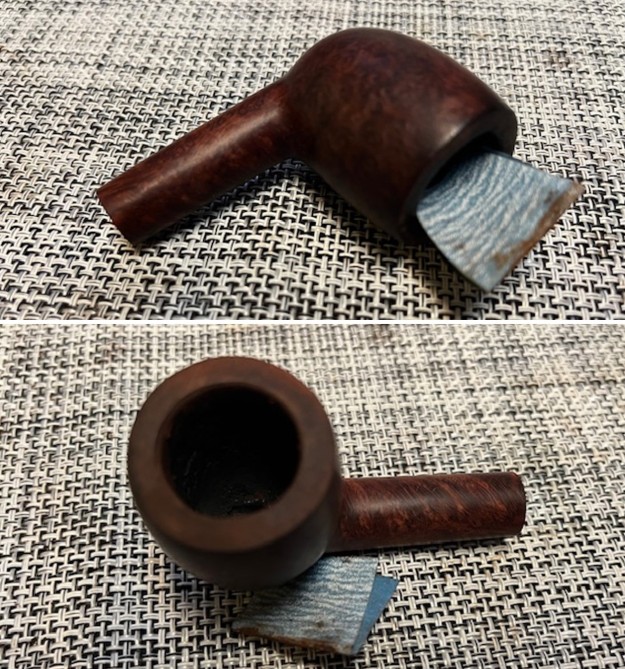 I polished the briar with micromesh sanding pads. I dry sanded it with 1500-12000 grit sanding pads and wiped the bowl down after each pad with a damp cloth. By the final pads the briar really had a shine.
I polished the briar with micromesh sanding pads. I dry sanded it with 1500-12000 grit sanding pads and wiped the bowl down after each pad with a damp cloth. By the final pads the briar really had a shine.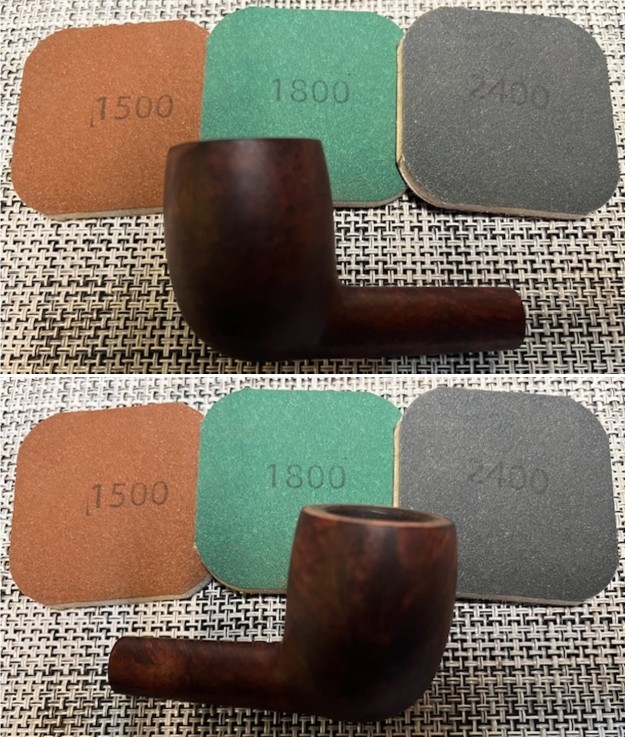
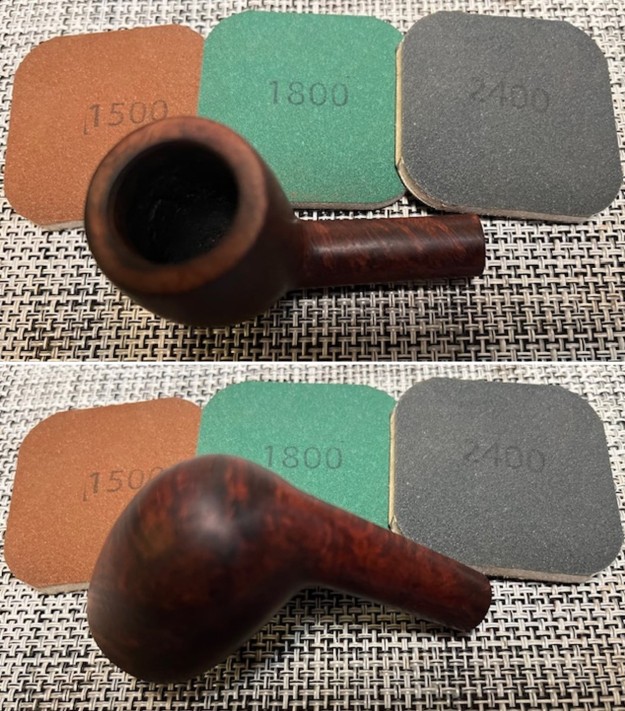
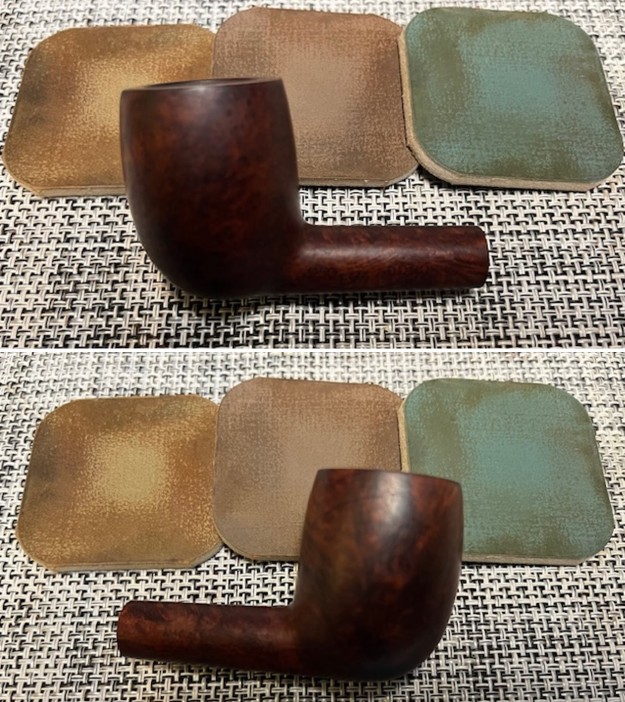
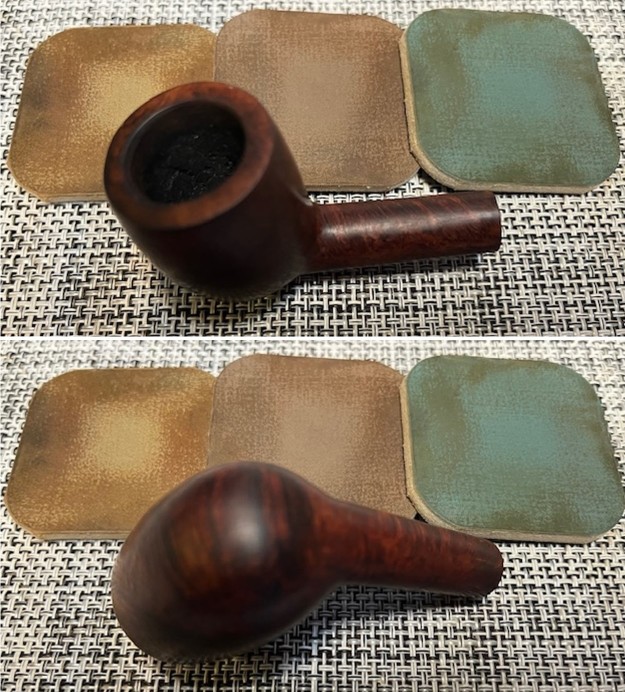
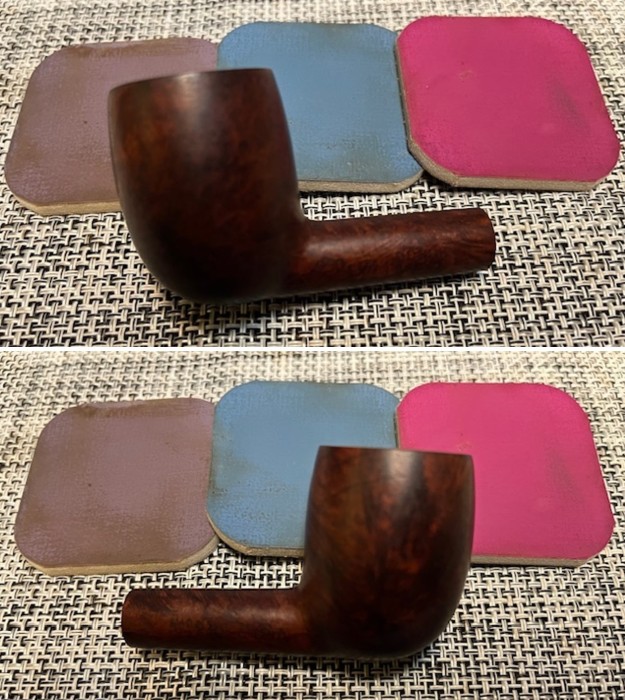
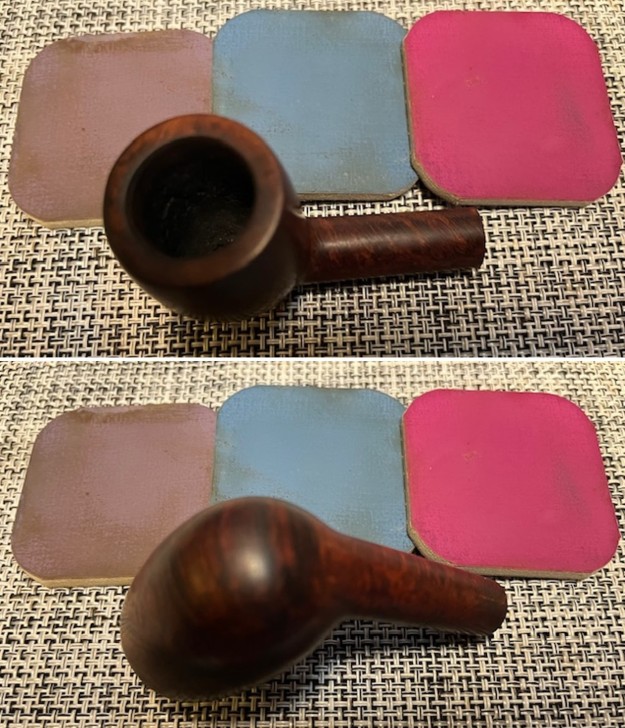 The bowl had a trough worn in the bottom caused by aggressive use of pipe cleaners. I mixed up a batch of pipe mud – cigar ash and water and put a pipe cleaner in the airway. I pressed the pipe mud into the trough with a dental spatula and a folded pipe cleaner to raise the bottom of the bowl.
The bowl had a trough worn in the bottom caused by aggressive use of pipe cleaners. I mixed up a batch of pipe mud – cigar ash and water and put a pipe cleaner in the airway. I pressed the pipe mud into the trough with a dental spatula and a folded pipe cleaner to raise the bottom of the bowl.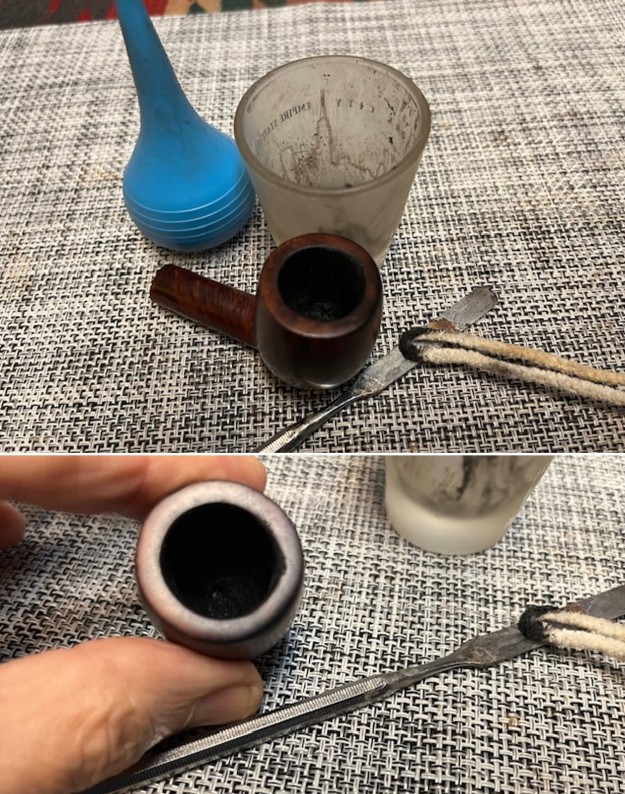 I rubbed the briar down with Before & After Restoration Balm. I worked it into the briar with my fingertips. The product works to clean, enliven and preserve the briar. I let it sit for 10 minutes then I buffed it with a cotton cloth to deepen the shine. The briar comes alive with the balm.
I rubbed the briar down with Before & After Restoration Balm. I worked it into the briar with my fingertips. The product works to clean, enliven and preserve the briar. I let it sit for 10 minutes then I buffed it with a cotton cloth to deepen the shine. The briar comes alive with the balm.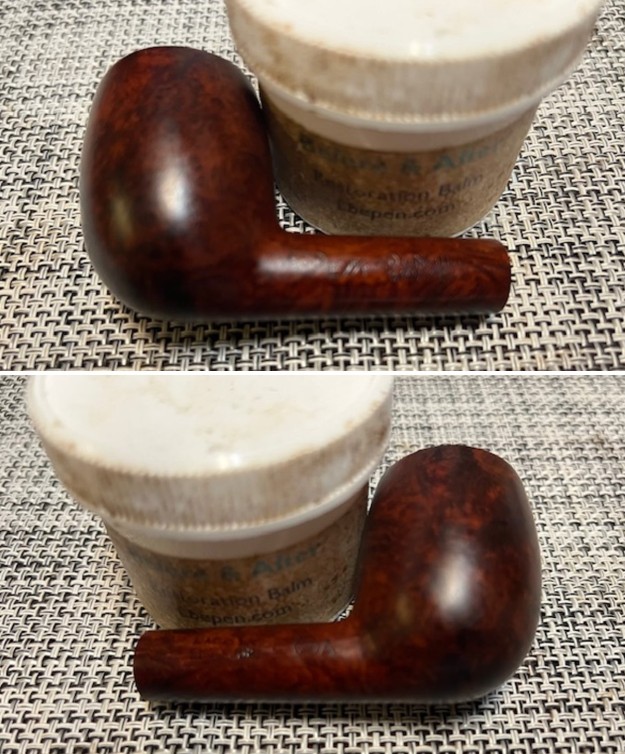
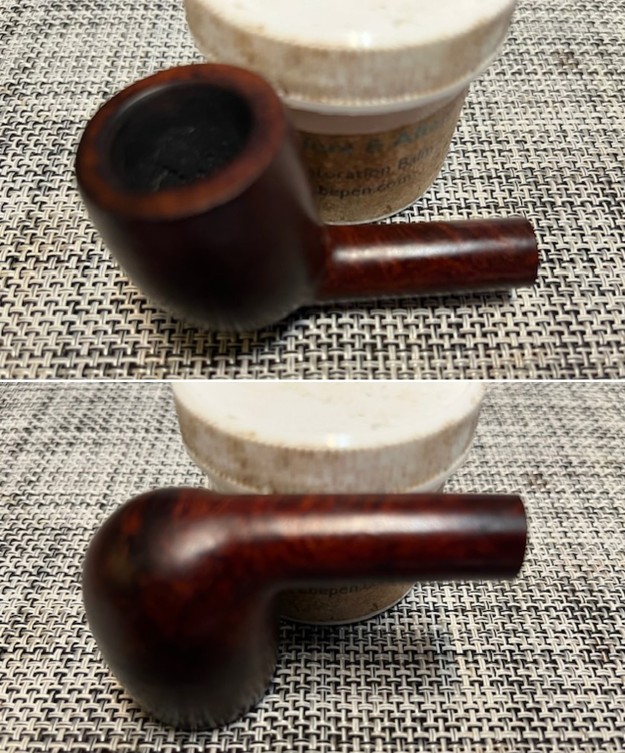
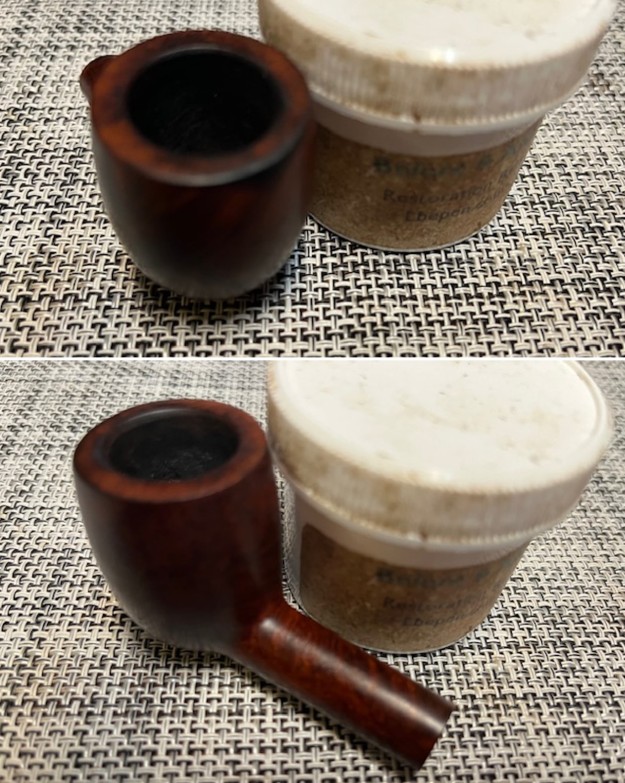 I set the bowl aside and turned my attention to the stem. I “painted” the stem with the flame of a light to lift the tooth marks from the surface. I was able to lift them significantly. I filled in what remained with a clear CA glue. I used some small files to flatten out the repairs to the surface. I sanded what remained with a folded piece of 220 grit sandpaper. The stem really began to look very good.
I set the bowl aside and turned my attention to the stem. I “painted” the stem with the flame of a light to lift the tooth marks from the surface. I was able to lift them significantly. I filled in what remained with a clear CA glue. I used some small files to flatten out the repairs to the surface. I sanded what remained with a folded piece of 220 grit sandpaper. The stem really began to look very good. 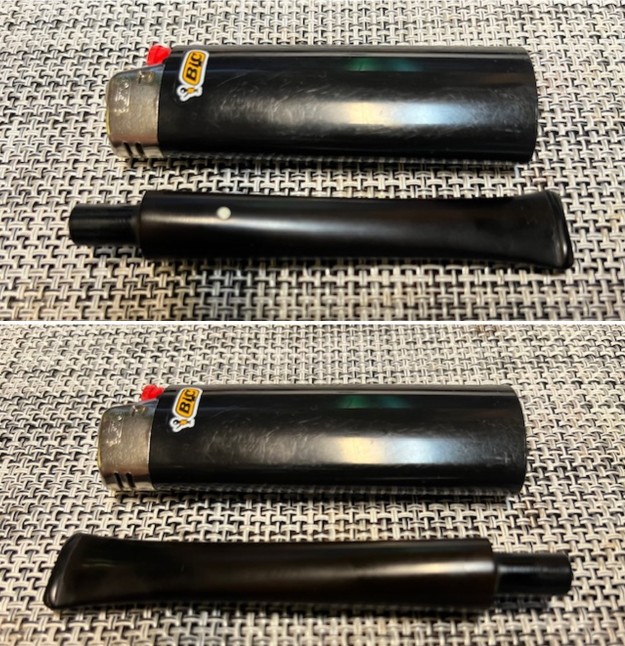
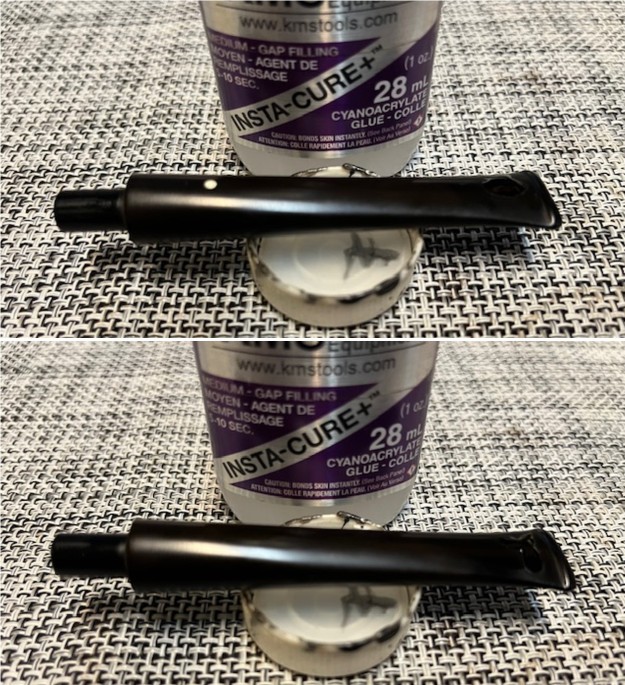
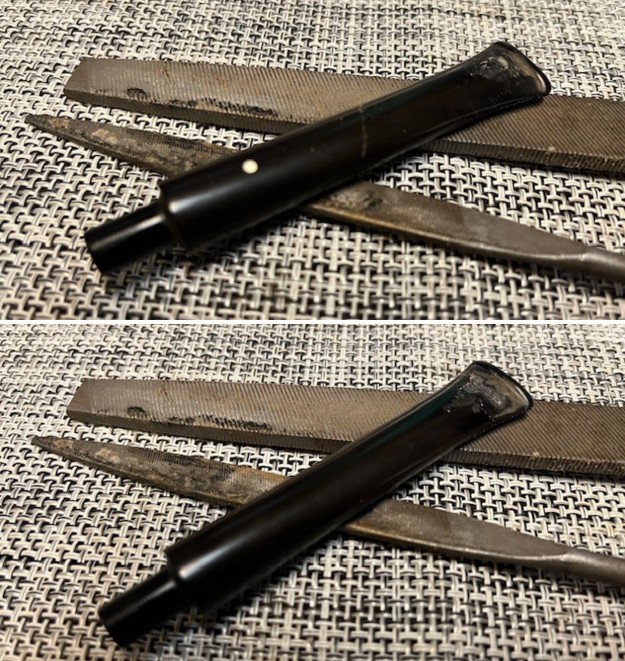
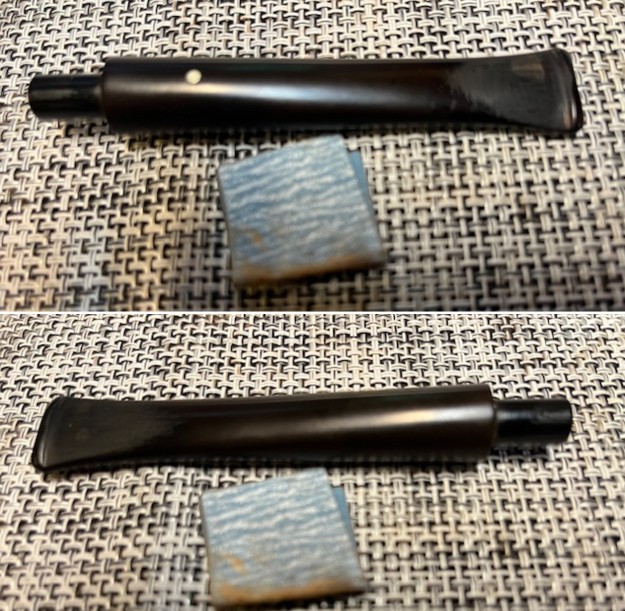 I sanded the stem with sanding pads- using 3200-3500 grit sanding pads. I wiped the stem down with a cloth impregnated with Obsidian Oil after each sanding pad. The stem was beginning to look much better.
I sanded the stem with sanding pads- using 3200-3500 grit sanding pads. I wiped the stem down with a cloth impregnated with Obsidian Oil after each sanding pad. The stem was beginning to look much better.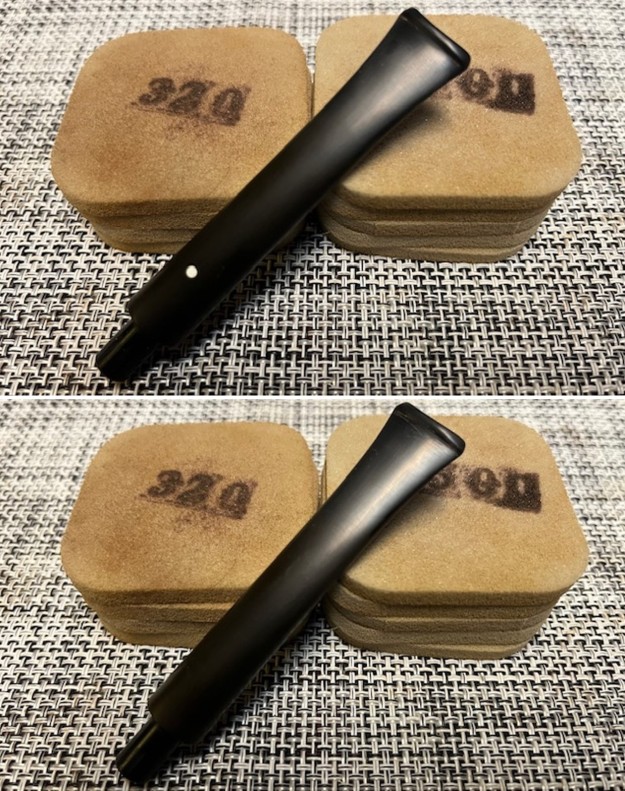 I polished the vulcanite with micromesh sanding pads – 1500-12000 grit pads. I wiped it down with Obsidian Oil after each sanding pad. I used Before & After Pipe Polish – both Fine and Extra Fine to further polish the stem. It really took on a shine and I knew that once it was buffed it would look amazing.
I polished the vulcanite with micromesh sanding pads – 1500-12000 grit pads. I wiped it down with Obsidian Oil after each sanding pad. I used Before & After Pipe Polish – both Fine and Extra Fine to further polish the stem. It really took on a shine and I knew that once it was buffed it would look amazing.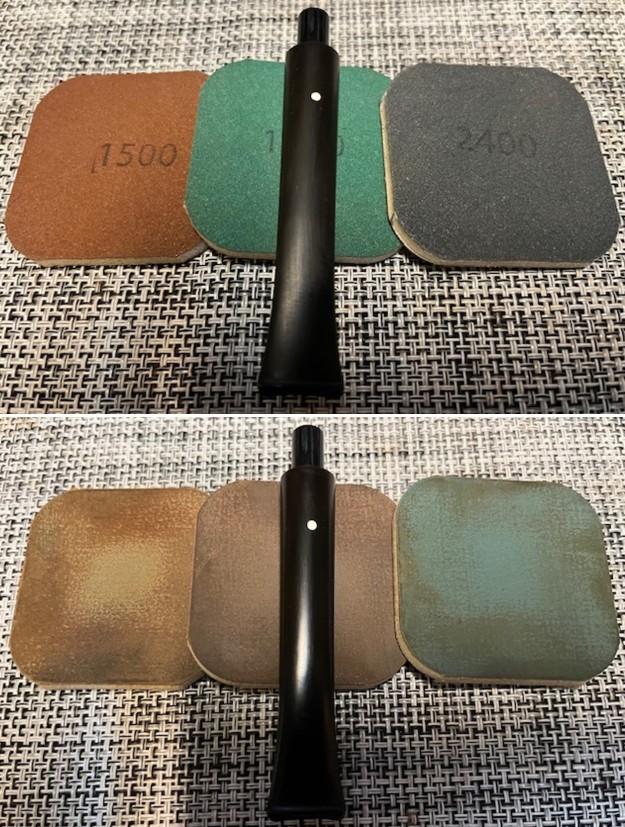
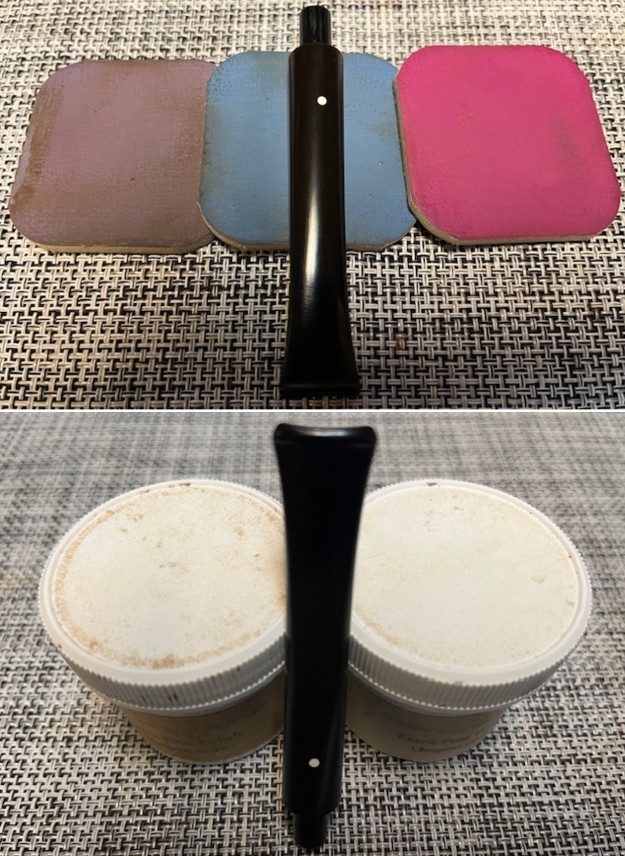 This Dunhill Bruyere 250EX F/T Group 2A Billiard from 1962 is a beautiful looking piece of briar that has a shape that follows grain. It is a great looking pipe that came out looking even better after the cleanup. The Bruyere is an early finish that Dunhill specialized in making. The finish on the pipe cleaned up well. The red and brown stain on the bowl works well to highlight the grain. The polished black vulcanite taper stem adds to the mix. With the grime gone from the finish and the bowl it was a beauty and is eye-catching. There was some burn damage on the outer edge of the bowl that remained. I put the stem back on the bowl and buffed the pipe with Blue Diamond on the buffing wheel being careful to not buff the stamping. I gave the bowl and the stem multiple coats of carnauba wax on the buffing wheel and buffed it with a clean buffing pad. I hand buffed the pipe with a microfiber cloth to deepen the shine. The finished Bruyere 250EX F/T Billiard is quite nice and feels great in the hand. Give the finished pipe a look in the photos below. I can only tell you that like the other pipes I am working that it is much prettier in person than the photos capture. The dimensions of the pipe are Length: 5 ½ inches, Height: 1 ½ inches, Outside diameter of the bowl: 1 inch, Chamber diameter: ¾ of an inch. The weight of the pipe is 27 grams/.95 ounces. It will soon be added to the British Pipe Makers Section on the rebornpipes store. Thanks for walking through the restoration with me as I worked over another beautiful pipe. Remember we are not pipe owners; we are pipemen and women who hold our pipes in trust until they pass on into the trust of the next generation.
This Dunhill Bruyere 250EX F/T Group 2A Billiard from 1962 is a beautiful looking piece of briar that has a shape that follows grain. It is a great looking pipe that came out looking even better after the cleanup. The Bruyere is an early finish that Dunhill specialized in making. The finish on the pipe cleaned up well. The red and brown stain on the bowl works well to highlight the grain. The polished black vulcanite taper stem adds to the mix. With the grime gone from the finish and the bowl it was a beauty and is eye-catching. There was some burn damage on the outer edge of the bowl that remained. I put the stem back on the bowl and buffed the pipe with Blue Diamond on the buffing wheel being careful to not buff the stamping. I gave the bowl and the stem multiple coats of carnauba wax on the buffing wheel and buffed it with a clean buffing pad. I hand buffed the pipe with a microfiber cloth to deepen the shine. The finished Bruyere 250EX F/T Billiard is quite nice and feels great in the hand. Give the finished pipe a look in the photos below. I can only tell you that like the other pipes I am working that it is much prettier in person than the photos capture. The dimensions of the pipe are Length: 5 ½ inches, Height: 1 ½ inches, Outside diameter of the bowl: 1 inch, Chamber diameter: ¾ of an inch. The weight of the pipe is 27 grams/.95 ounces. It will soon be added to the British Pipe Makers Section on the rebornpipes store. Thanks for walking through the restoration with me as I worked over another beautiful pipe. Remember we are not pipe owners; we are pipemen and women who hold our pipes in trust until they pass on into the trust of the next generation.